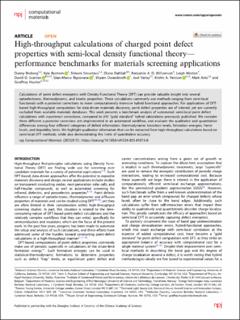| dc.contributor.author | Broberg, Danny | |
| dc.contributor.author | Bystrom, Kyle | |
| dc.contributor.author | Srivastava, Shivani | |
| dc.contributor.author | Dahliah, Diana | |
| dc.contributor.author | Williamson, Benjamin Albert Dobson | |
| dc.contributor.author | Weston, Leigh | |
| dc.contributor.author | Scanlon, David O. | |
| dc.contributor.author | Rignanese, Gian-Marco | |
| dc.contributor.author | Dwaraknath, Shyam | |
| dc.contributor.author | Varley, Joel | |
| dc.contributor.author | Persson, Kristin A. | |
| dc.contributor.author | Asta, Mark | |
| dc.contributor.author | Hautier, Geoffroy | |
| dc.date.accessioned | 2023-10-31T07:30:17Z | |
| dc.date.available | 2023-10-31T07:30:17Z | |
| dc.date.created | 2023-05-26T10:20:11Z | |
| dc.date.issued | 2023 | |
| dc.identifier.citation | npj Computational Materials. 2023, 9 (1), . | en_US |
| dc.identifier.issn | 2057-3960 | |
| dc.identifier.uri | https://hdl.handle.net/11250/3099561 | |
| dc.description.abstract | Calculations of point defect energetics with Density Functional Theory (DFT) can provide valuable insight into several optoelectronic, thermodynamic, and kinetic properties. These calculations commonly use methods ranging from semi-local functionals with a-posteriori corrections to more computationally intensive hybrid functional approaches. For applications of DFT-based high-throughput computation for data-driven materials discovery, point defect properties are of interest, yet are currently excluded from available materials databases. This work presents a benchmark analysis of automated, semi-local point defect calculations with a-posteriori corrections, compared to 245 “gold standard” hybrid calculations previously published. We consider three different a-posteriori correction sets implemented in an automated workflow, and evaluate the qualitative and quantitative differences among four different categories of defect information: thermodynamic transition levels, formation energies, Fermi levels, and dopability limits. We highlight qualitative information that can be extracted from high-throughput calculations based on semi-local DFT methods, while also demonstrating the limits of quantitative accuracy. | en_US |
| dc.language.iso | eng | en_US |
| dc.publisher | Nature | en_US |
| dc.rights | Navngivelse 4.0 Internasjonal | * |
| dc.rights.uri | http://creativecommons.org/licenses/by/4.0/deed.no | * |
| dc.title | High-throughput calculations of charged point defect properties with semi-local density functional theory—performance benchmarks for materials screening applications | en_US |
| dc.title.alternative | High-throughput calculations of charged point defect properties with semi-local density functional theory—performance benchmarks for materials screening applications | en_US |
| dc.type | Peer reviewed | en_US |
| dc.type | Journal article | en_US |
| dc.description.version | publishedVersion | en_US |
| dc.source.pagenumber | 0 | en_US |
| dc.source.volume | 9 | en_US |
| dc.source.journal | npj Computational Materials | en_US |
| dc.source.issue | 1 | en_US |
| dc.identifier.doi | 10.1038/s41524-023-01015-6 | |
| dc.identifier.cristin | 2149479 | |
| cristin.ispublished | true | |
| cristin.fulltext | original | |
| cristin.qualitycode | 1 | |

